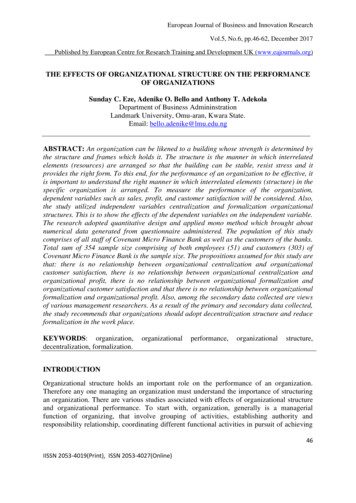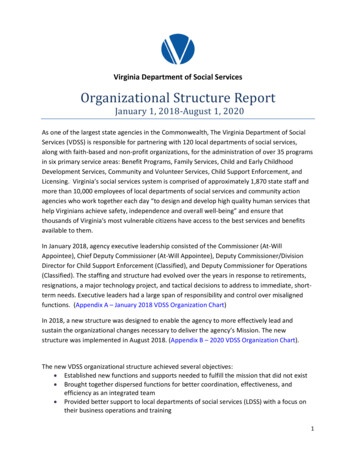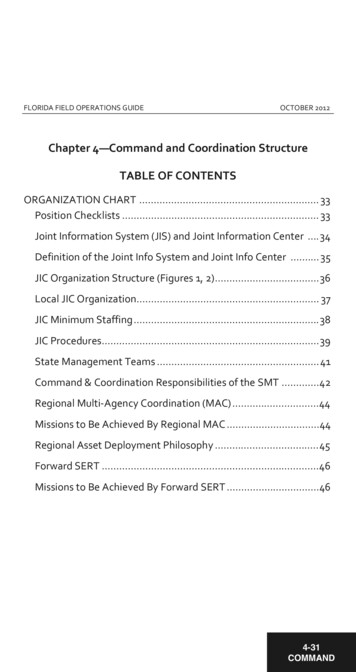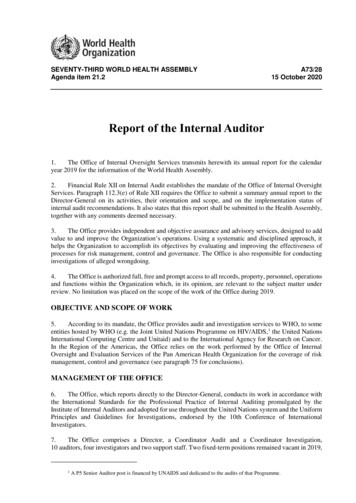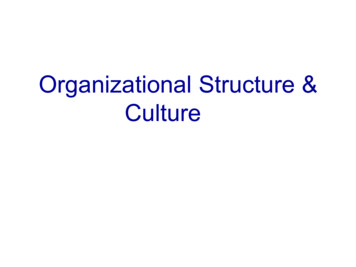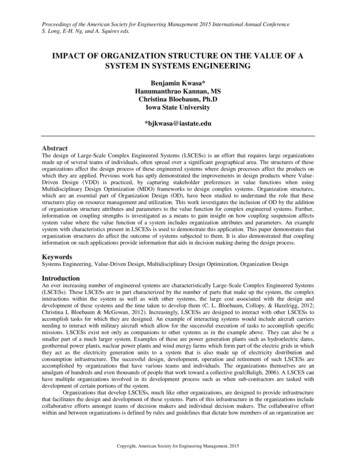
Transcription
Proceedings of the American Society for Engineering Management 2015 International Annual ConferenceS. Long, E-H. Ng, and A. Squires eds.IMPACT OF ORGANIZATION STRUCTURE ON THE VALUE OF ASYSTEM IN SYSTEMS ENGINEERINGBenjamin Kwasa*Hanumanthrao Kannan, MSChristina Bloebaum, Ph.DIowa State University*bjkwasa@iastate.eduAbstractThe design of Large-Scale Complex Engineered Systems (LSCESs) is an effort that requires large organizationsmade up of several teams of individuals, often spread over a significant geographical area. The structures of theseorganizations affect the design process of these engineered systems where design processes affect the products onwhich they are applied. Previous work has aptly demonstrated the improvements in design products where ValueDriven Design (VDD) is practiced, by capturing stakeholder preferences in value functions when usingMultidisciplinary Design Optimization (MDO) frameworks to design complex systems. Organization structures,which are an essential part of Organization Design (OD), have been studied to understand the role that thesestructures play on resource management and utilization. This work investigates the inclusion of OD by the additionof organization structure attributes and parameters to the value function for complex engineered systems. Further,information on coupling strengths is investigated as a means to gain insight on how coupling suspension affectssystem value where the value function of a system includes organization attributes and parameters. An examplesystem with characteristics present in LSCESs is used to demonstrate this application. This paper demonstrates thatorganization structures do affect the outcome of systems subjected to them. It is also demonstrated that couplinginformation on such applications provide information that aids in decision making during the design process.KeywordsSystems Engineering, Value-Driven Design, Multidisciplinary Design Optimization, Organization DesignIntroductionAn ever increasing number of engineered systems are characteristically Large-Scale Complex Engineered Systems(LSCESs). These LSCESs are in part characterized by the number of parts that make up the system, the complexinteractions within the system as well as with other systems, the large cost associated with the design anddevelopment of these systems and the time taken to develop them (C. L. Bloebaum, Collopy, & Hazelrigg, 2012;Christina L Bloebaum & McGowan, 2012). Increasingly, LSCESs are designed to interact with other LSCESs toaccomplish tasks for which they are designed. An example of interacting systems would include aircraft carriersneeding to interact with military aircraft which allow for the successful execution of tasks to accomplish specificmissions. LSCESs exist not only as companions to other systems as in the example above. They can also be asmaller part of a much larger system. Examples of these are power generation plants such as hydroelectric dams,geothermal power plants, nuclear power plants and wind energy farms which form part of the electric grids in whichthey act as the electricity generation units to a system that is also made up of electricity distribution andconsumption infrastructure. The successful design, development, operation and retirement of such LSCESs areaccomplished by organizations that have various teams and individuals. The organizations themselves are anamalgam of hundreds and even thousands of people that work toward a collective goal(Baligh, 2006). A LSCES canhave multiple organizations involved in its development process such as when sub-contractors are tasked withdevelopment of certain portions of the system.Organizations that develop LSCESs, much like other organizations, are designed to provide infrastructurethat facilitates the design and development of these systems. Parts of this infrastructure in the organizations includecollaborative efforts amongst teams of decision makers and individual decision makers. The collaborative effortwithin and between organizations is defined by rules and guidelines that dictate how members of an organization areCopyright, American Society for Engineering Management, 2015
Kwasa, Kannan & Bloebaumable to interact. This results in predetermined forms of communication and information flow that define the structureof the organization (Baligh, 2006; Galbraith; Harris & Raviv, 2002). Every organization has an organizationstructure established primarily to identify and guide the collaborative effort within the organization. LSCESsdemand large organizations to accomplish the desired goal of developing these systems. An example of anorganization that develops LSCESs is the Boeing Company that, as of April 30th, 2015, has 162,290 employees with83,406 in the commercial airplanes division, 50,829 in the defense, space and security division and 17,360 in thecorporate division of the company ("Boeing Employment Data," 2015). A second example is the NationalAeronautics and Space Administration (NASA) which, as of May 2 nd, 2015, has 17,338 employees. In additionNASA has over 40,000 contractors and grantees ("NASA Workfoce Data," 2015). A presence of interfaces withinthe organization serves as a resolve for the need to relay information during the design and development ofengineered systems. This provides the organization’s structure (Baligh, 2006; Mintzberg, 1980). Engineered systemsdemand a structure that caters to the relaying of information that is required in various parts of the organization. Thisinformation relates to the physics of the system itself. The organization’s structure dictates the manner in which thisinformation is relayed within the organization as this structure delineates the members of the organization that candirectly share information. The information that relates to the physics of the engineered system is referred to asphysics-based couplings while the prescribed information sharing within the organization constitutes organizationcouplings.The Multidisciplinary Design Optimization (MDO) community has incorporated the use of DesignStructure Matrices (DSMs) to represent different kinds of couplings present in the design of complex systems.Physics-based couplings are represented by the use of physics-based DSMs while organizational couplings aretypically represented using team-based DSMs (C. Bloebaum, Hajela, & Sobieszczanski-Sobieski, 1992; Yassine,2004). With these two DSMs, it is possible to show information that needs to be shared between or amongstmembers of the organization as well as the team members or individuals that have a provision for communicationwithin the organization. This however does not shed light as to which infrastructure provides the best means todevelop LSCESs. In the same way, alternatives are evaluated to identify the best design choice; it is the desire of theauthors to attain a rigorous and mathematically sound means to evaluate the organization structures that make itpossible to design engineered systems.Value-Driven Design (VDD) aids in the formulation of value functions that provide the value of a systemwithin the defined design space. When applied in conjunction with MDO, an objective function is replaced with avalue function that relates the physics of the system to the desired preference with regard to the system that isrepresented as value (P. D. Collopy & Hollingsworth, 2011; B. L. Mesmer, Bloebaum, & Kannan, 2013). Thisprovides for a shift from the traditional approach to Systems Engineering (SE) which utilizes frameworks such asthe V-Model, Waterfall model and Spiral model; all of which are requirements based systems engineeringtechniques. As a result, these traditional SE techniques rely on the formulation of requirements at different levels ofthe organization through decomposition (C. Bloebaum et al., 1992; Buede, 2009). Two areas of a design space aredefined in this way; the feasible and infeasible. There is no means provided by traditional methods tomathematically identify a superior design in the feasible space. VDD provides a means to capture true stakeholderpreferences, e.g. profit, thereby allowing for comparison of alternatives throughout the design space (P. D. Collopy& Poleacovschi, 2012; B. Mesmer, Bloebaum, & Kannan, 2014). Past research has focused on combining VDD andMDO to improve the design process of LSCESs (B. Mesmer et al., 2014; B. L. Mesmer et al., 2013). The authorsherein focus on the incorporation of Organization Design (OD) in the design process to improve the SystemsEngineering process by including both product and process in the formulation of value functions to more accuratelyrepresent LSCESs.BackgroundMultidisciplinary Design OptimizationMDO is an approach to design optimization whose development began in the 1980s primarily to address complexoptimization problems such as those faced with complex systems (Cramer, Dennis, Frank, Lewis, & Shubin, 1994;Sobieszczanski-Sobieski & Haftka, 1997; Tedford & Martins, 2010). Frameworks developed in MDO provide themeans and techniques necessary to perform analyses of subsystems when designing LSCESs. Objective functionsutilized by these frameworks allow for single or multiple performance objectives that relate to the engineeredsystem.Another principality of MDO is its effectiveness in identification and utilization of couplings that areestablished during the decomposition of complex systems. Exhibit 1 is an example of a fully coupled system withthree subsystems namely A, B and C. The design variables are the Xs and the outputs of the subsystems are Yswhich are also behavior variables that act as inputs to the subsystems from which they did not originate. Past2
Kwasa, Kannan & Bloebaumresearch work has focused on using information on physics-based couplings in an engineered system to improve thedesign process (C. Bloebaum, 1995; English, Bloebaum, & Miller, 2001; English, Miller, & Bloebaum, 1996;Rogers & Bloebaum, 1994).Exhibit 1. Example of a Coupled System with a Global Sensitivity Equation.ABC I YB YA YA YB I dYA dXA dYB dX AdYA YAdX B X A dYB 0dX B 0 YB X B The global sensitivity equation (GSE), an example of which is in Exhibit 1 that would apply to the coupledsystem aforementioned, uses local sensitivities to calculate global sensitivities thereby determining system behaviorand in so doing, quantify system couplings. Researchers have used this technique to demonstrate improvedefficiency in design through coupling suspension and sequencing in an engineered system (English et al., 2001;English et al., 1996). To date, implementation of MDO in the design of LSCESs does not include the effects of theorganization structure on the system. This work serves as an example of the inclusion of organization structures inthe design of LSCESs.Value-Driven DesignVDD is an approach to systems engineering that focuses on appropriately representing stakeholder preferences invarious facets of the design process. This ideology allows for a reduced focus on requirements development anddispersion throughout an organization during the design and development of LSCESs by capturing true stakeholderpreferences. Exhibit 2 illustrates a VDD approach to systems engineering for LSCESs.Exhibit 2. VDD Approach to Design of LSCESs.These preferences are captured in a value function when used in MDO (P. Collopy, Bloebaum, & Mesmer,2012; B. Mesmer et al., 2014). In order to effectively use VDD in MDO frameworks, the design variables, behaviorvariables and system attributes that characterize the system are used to define the value function. The decompositionand dissemination of a value function to subsystems allows for the design of a system that represents unifiedstakeholder preference. In so doing, a platform for unified decision making is created throughout the organization.Including the characteristics of an organization’s structure is explored in this work to allow for both product(physical system) and process (organization) to contribute to the understanding of a system’s value.Organization DesignOrganization Design deals with the structural operation of an organization. This includes five aspects: strategy,structure, reward systems, human resource management and business processes. Of these aspects, the authors’interest lies primarily in structure and its effects on LSCES. The organization structure is characterized by thedelegation of power and authority, the flow of information and execution of tasks (Galbraith; Harris & Raviv, 2002).3
Kwasa, Kannan & BloebaumThe ordering of entities in the organization along with the delegation of the mentioned characteristics gives anorganization its structure. As an example, entities whose primary tasks are specialization tasks are more so found atlower levels of an organization and are referred to as low level decision-makers. while those that have a larger focuson coordination are found at higher levels in an organization (Mintzberg, 1980) and are commonly referred to asmanagers. Coordination tasks, in this case, are any effort that results in the transposition of information from anorigin entity to a destination entity or an intermediate entity. Higher level decision-makers fall into this secondgroup. Specialization tasks are those that result in the generation of information by an entity that is tasked with thecreation of this information in the organization. Additionally, a task is not considered a specialization task if it theinformation generated by the execution of that task can be generated in an entity other that the one referenced. It isthis aspect of organization design that this work includes in the VDD approach to the design of engineered systems.Traditionally, OD is used as a driver for efficient resource utilization during the lifecycle of an organization and itsprojects.Past research has demonstrated that large organizations more often than not, choose to utilize hierarchicalstructures as opposed to decentralized structures (spider web) (Baligh, 2006; Child, 1973). This is especially true fororganizations that develop predetermined products or systems. LSCESs which need large organizations traditionallyfollow this trend and thus are primarily found to contain structures that are hierarchical in nature. Research has alsosupported ‘the mirroring hypothesis’ which addresses the similarities to organizations’ structures and their productstructures. These works have shown that there is a strong correlation to organization structures and their productstructures (Cabigiosu & Camuffo, 2012; Colfer & Baldwin, 2010; MacCormack, Rusnak, & Baldwin, 2008). Twoobservations are made from studies on the mirroring hypothesis. First, organizations that develop products orsystems that have tight physics-based couplings develop products and systems whose product structure ‘mirrors’(mimics) the organization’s structure. This is a result of rules and regulations that govern the organization beingprojected onto the process followed during product development. Secondly, organizations use of resources duringdevelopment is most efficient when the organization and product structures are a replication of each other(Colfer &Baldwin, 2010).Past research work in MDO has investigated the capability to improve design of LSCESs by looking atdecomposition and physics-based couplings (C. Bloebaum, 1995; C. Bloebaum et al., 1992; English et al., 2001).This led to the work on use of coupling strengths to improve efficiency in design by coupling suspension (English etal., 2001; English et al., 1996). VDD on the other hand has provided a means to accurately capture stakeholderpreference as a value function when applied to MDO (P. D. Collopy & Poleacovschi, 2012; B. L. Mesmer et al.,2013). The authors of this work herein move to include OD in the design process alongside VDD and MDO to gainan understanding of how value of a LSCES is affected by the design of an organization. This paper introducesattributes associated with the organization structure to the value function of complex systems thereby highlightingthe impact of product and process on the design of complex systems.Complex SystemThe demonstration of an improved systems engineering process in this work is conducted on a sample complexsystem. This system is a simplified example of a complex engineered system. It is the goal of the authors to use thisexample system to demonstrate the application where the system maintains characteristics of complex engineeredsystems while being a small enough scale to allow for traceability of behavior throughout the system from thelowest level to the value function. Exhibit 3 is an illustration of the sample complex system.Exhibit 3. Example of a complex system.𝑉 2𝐴111 𝐴121𝐴111 2𝐴211 𝐴221 𝐴241 2𝑥2𝐴121 3𝐴231 2𝐴241 𝑥4𝐴211 𝑥1 2𝑥3 𝑥12 𝐴221𝐴𝐴221 𝑥22 2112(1)(2)(3)(4)(5)4
Kwasa, Kannan & Bloebaum𝐴231 𝑥3 𝑥4 3𝑥3 𝐴241 𝑥4 𝑥6 𝑥52𝐴2412 5𝐴211 𝐴231(6)(7)In this system, the X’s (X1, X2 ) are the system design variables. These are the variables that can be alteredby decision makers to change the behavior of the system. Examples of these include the chord of an airfoil sectionon an aircraft, the diameter of the cylinder on a reciprocating engine and, the length, width or diameter of a fueltank. The A’s in the system are subsystem outputs. They represent inputs to other systems (behavior variables) aswell as system attributes (characteristics). An example of a behavior variable is capacity of a fuel tank in terms ofvolume. This information can be used by a different entity in the system to obtain information on the range of avehicle if the fuel consumption at cruising speed is available. V in the system is the highest level output which isobtained from the value function. As such, it gives the value associated with the physics-based system calculated.Where VDD is applied to the design process for commercial industries, the value can be expressed as profit. Thesystem attributes (A’s) act as inputs to the value function thereby relating the characteristics of the system to the truepreferences of its stakeholders. Organization Design is now introduced into the evaluation of the system by takinginto account the structure of the organization that would develop the system.Organization StructuresTo demonstrate the effect of organization structures on systems, the authors utilize two aspects of organizationstructures, task execution and information links. There are two types of tasks that can be performed by any givenentity in the organization namely, coordination tasks and specialization tasks. These tasks are further broken downinto the cost associated with each task as well as the time taken to execute the tasks. The information links on theother hand prescribe the authorized communication between entities in the organization thereby characterizing theorganization’s structure. The tasks’ cost and time parameters contribute to the systems value function. The costs addup to provide the cost of the organization while the times to execute tasks provide the duration to develop a specificdesign by summing up the times for the critical path in the system (Ertas & Jones, 1993). This duration is thenfactored into the profit portion of the value function to account for the time value of money. The organization costcalculation associated with the design is included in the calculation of the value function. For a complex engineeredsystem in the commercial sector, stakeholders’ preferences would appropriately be represented as a net presentprofit function (value function) where both the process and product are now accounted for in the value function.Exhibit 4 illustrates the durations per task and unit cost values assigned to the organization structure parameters forthe system presented in Exhibit 3.Exhibit 4. Organization Parameter Values for Sample System.Organization ParameterUnit CostUnit Task Duration (months)Spec. S1 (V)3.01.0Spec. S11 (A111)1.21.0Spec. S12 (A121)1.151.0Spec. S21 (A211)0.12.0Spec. S22 (A221)0.22.7Spec. S23 (A231)0.12.1Spec. S24 (A241)0.152.5Coord. SSL10.0750.25Coord. SSL20.030.25The first organization structure incorporated into the value function of the complex system presented inExhibit 3 is a pure hierarchy. In a pure hierarchy all information links are vertical, i.e. information is passed up to amanaging entity or passed down from a managing entity. There are no lateral information links that permit thepassing of information from entities within the same level of an organization. In the evaluation of the cost of theorganization on the design process, the total cost of developing a design is obtained from a two part summation. Theproducts of the cost to execute a single task and the number of tasks executed during an analysis for each entity inthe organization are summed with the products of the cost to relay information (coordination cost) and the numberof times an entity in the organization relays information during the analysis to evaluate a design of the complex5
Kwasa, Kannan & Bloebaumsystem (Eq. 8 to Eq. 12). Information on the total organization costs associated with task specialization, taskcoordination and duration of system development are collected and presented later in this paper. Exhibit 5 is anillustration of the pure hierarchy structure with information links.Exhibit 5. Pure Hierarchy Structure.𝐶𝑜𝑠𝑡𝑜𝑟𝑔 𝐶𝑜𝑠𝑡𝑠𝑝𝑒𝑐 ��𝑠𝑝𝑒𝑐 𝐶𝑜𝑠𝑡𝑠𝑝𝑒𝑐𝑆1 2𝑖 1 ��𝑜𝑠𝑡𝑐𝑜𝑜𝑟𝑑 𝐶𝑜𝑠𝑡𝑐𝑜𝑜𝑟𝑑𝑆1 2𝑖 1 ��𝐶𝑜𝑠𝑡𝑠𝑝𝑒𝑐𝑆𝑆𝐿𝑖 𝑚𝑗 1(𝑠𝑐𝑗 )𝑆𝑗𝑤ℎ𝑒𝑟𝑒 𝑚 𝑛𝑢𝑚𝑏𝑒𝑟 𝑜𝑓𝑠𝑢𝑏𝑠𝑦𝑠𝑡𝑒𝑚𝑠 𝑖𝑛 𝑆𝑆𝐿𝑖𝑠𝑐𝑗 𝑛𝑢𝑚𝑏𝑒𝑟 𝑜𝑓 ��𝑛 �� 𝑡ℎ𝑒 𝑗 𝑡ℎ 𝑠𝑢𝑏𝑠𝑦𝑠𝑡𝑒𝑚𝑆𝑗 𝑢𝑛𝑖𝑡 𝑐𝑜𝑠𝑡 𝑜𝑓 ��𝑛 𝑓𝑜𝑟 𝑡ℎ𝑒 𝑗 𝑡ℎ ��𝑐𝑜𝑜𝑟𝑑𝑆𝑆𝐿𝑖 𝑚𝑗 1(𝑐𝑐𝑗 )𝐶𝑗𝑤ℎ𝑒𝑟𝑒 𝑚 𝑛𝑢𝑚𝑏𝑒𝑟 𝑜𝑓𝑠𝑢𝑏𝑠𝑦𝑠𝑡𝑒𝑚𝑠 𝑖𝑛 𝑆𝑆𝐿𝑖𝑐𝑐𝑗 𝑛𝑢𝑚𝑏𝑒𝑟 𝑜𝑓 𝑐𝑜𝑜𝑟𝑑𝑖𝑛𝑎𝑡𝑖𝑜𝑛 �� 𝑡ℎ𝑒 𝑗 𝑡ℎ 𝑠𝑢𝑏𝑠𝑦𝑠𝑡𝑒𝑚𝐶𝑗 𝑢𝑛𝑖𝑡 𝑐𝑜𝑠𝑡 𝑜𝑓 𝑐𝑜𝑜𝑟𝑑𝑖𝑛𝑎𝑡𝑖𝑜𝑛 𝑓𝑜𝑟 𝑡ℎ𝑒 𝑗 𝑡ℎ (12)The second organization structure the system is tested against is a completely mirrored structure. Incomplete mirroring, the organization structure is designed to mimic the physics-based structure of the system to bedeveloped. As such, the couplings (information on physics-based relations in the system) are represented asinformation links (organization couplings) in the organization structure. Exhibit 6 is an illustration of the completemirroring structure with information links.Exhibit 6. Complete Mirroring.VA111A211A121A221A231A241In such a structure, vertical, lateral and a combination of both lateral and vertical information links areallowed depending on the nature of the physics-based decomposition. In Exhibit 6, there is a direct information linkfrom A211 to A231, which is a lateral in nature as well as a direct information link from A241 to A111, a link that is acombination of a lateral and a vertical link. This combination in the link results from the two entities being indifferent levels within the system where one of them is not an immediate superior to the other. Using the sameorganization parameters presented in table 1, the organization costs and duration to development are calculated andpresented in table 2 for the completely mirrored structure.6
Kwasa, Kannan & BloebaumExhibit 7. Partial Mirroring with no Direct Info Link from A211 to A231VA111A211A121A221A231A241As a third structure, a partially mirrored structure is used in the analysis of the system’s value. Exhibit 7illustrates this partial mirroring. It differs from the complete mirroring as a result of the exclusion of a directinformation link between A211 and A231. With this partial mirroring, the costs associated with the organization arecalculated. The duration to develop the system for the given set of design variables is also calculated. Theseattributes are used to calculate the system’s value which includes the physics-based product as well as the process.The final organization structure that is used to observe the impact of organization structures on system value in thiswork is another partial mirroring. This structure differs from the complete mirroring by virtue of lacking a directinformation link from A241 to A111. Similar to the data collected on the organization structures above, the costs andduration for development are calculated and presented in Exhibit 8 below.Exhibit 8. System Values with Differing Structures.Org.Structure(mirroredlink)SystemValue w/oDev. TimeSystemValue w/Dev. TimeΔ inSystemValueΔ in SystemValue w/Dev. TimeCoord.CostΔ inCoord.CostOrg.CostΔ inOrg.Cost% Δ inSystemValue w/oDev. Time% Δ inSystemValue w/Dev. TimePure .833.969.19Partial Mirror(A241 – Partial Mirror(A211 – It is observed from the sample data set presented in Exhibit 8 that the best organization structure for thiscomplex system, in terms of system value at 71.38, is the complete mirroring structure where the physics-basedsystem that was presented in Exhibit 3 has a structure with organization couplings that mirror its own physics-basedcouplings as was presented in Exhibit 6. The complete mirroring has the lowest overall coordination cost andtherefore the lowest organization cost given that the specialization costs are the same for all organization structuresto which the system is subjected. A Similar trend of system value was observed for several data points supportingthe findings that the complete mirroring is the best structure for this complex system in terms of system value. Thereis a greater percentage difference in the system value between the pure hierarchy structure and the other structureswhen a discount rate is introduced to the system value due to the time taken to develop the system. This difference isa direct result of the discount rate applied to the value function and points to the importance of capturing time as aparameter to the design of complex systems especially where revenue and cost are affected by duration to deliver anengineered system. Noteworthy to the impact of organization structures on the design of engineered systems is thatthe parameters that dictate the unit costs for coordination and specialization have a huge impact on the system valueat any given point in the design space. This also determined which of the two partial mirroring structures resulted ina system with higher value. The dependence on organization structures to provide higher system values (partialmirroring), points to the importance of the role an organization’s structure plays on the systems that organizationsdesign.Coupling StrengthsThe role of coupling strengths on the design of engineered systems is investigated in this work where, the value ofthe system includes the costs associated with the organization. Using the four organization structures as presented inthe section above, two couplings are suspended and the system values calculated to evaluate the impact of thecoupling suspension on the system value. The two attributes associated with the couplings investigated in this7
Kwasa, Kannan & Bloebaumsection are A211 and A241. An analysis on the system to obtain value is then performed with each of the organizationstructures presented earlier in this work. This is accomplished by setting the initial value for each attribute to tenpercent (10%) less than the converged value and evaluating the system value to determine which organizationstructure provides the smallest deviation in value. Exhibit 9 contains the evaluations of the systems value under thecoupling suspension when subjected to the four organization structures.Exhibit 9. System Values under Coupling Suspension.Org.Structure(mirroredlink)SystemValue w/oDev. TimeSystemValue w/Dev. TimeΔ in SystemValueΔ in SystemValue w/Dev. TimeSpec. CostCoord.CostOrg.Cost% Δ inSystemValue w/oDev. Time% Δ inSystemValue w/Dev. Time123Pure ure 11Pure 728.2411.5917.201Partial Mirror(A241 – ial Mirror(A241 – A111)Partial Mirror(A241 – A111)Partial Mirror(A211 – A231)Partial Mirror(A211 – A231)Partial Mirror(A211 – 1.5117.10#23123Attribute A211 has a normalized coupling strength of -0.7369 at the design point selected. Attribute A241 hasa normalized coupling strength of -0.1921. As such, A211 will result in a larger change in the physics-based value ofthe system for the same percentage change in value as that of A241.It is observed that of the four structures, the purehierarchy has the lowest system value both with and without the inclusion of development time. Of the twoattributes that were suspended, it is observable that the higher system value is obtained from the coupling suspensionwith a lower normalized coupling strength, A241. This is because with a lower normalized strength, there is morevalue gained in fewer task execution iterations and task coordination executions compared to the loss in value due tothe change in the attribute A241. This observation is reinforced by the lower changes in organization cost whencompared to those that accompany the coupling suspension associated with A211. Based on these results, couplingstrength information can be used when accompanied by the appropriate representation of organization structureattributes in a value function to assess trade-offs between revenue and cost of a system especially where resourcesare s
This provides the organization's structure (Baligh, 2006; Mintzberg, 1980). Engineered systems demand a structure that caters to the relaying of information that is required in various parts of the organization. This information relates to the physics of the system itself. The organization's structure dictates the manner in which this


